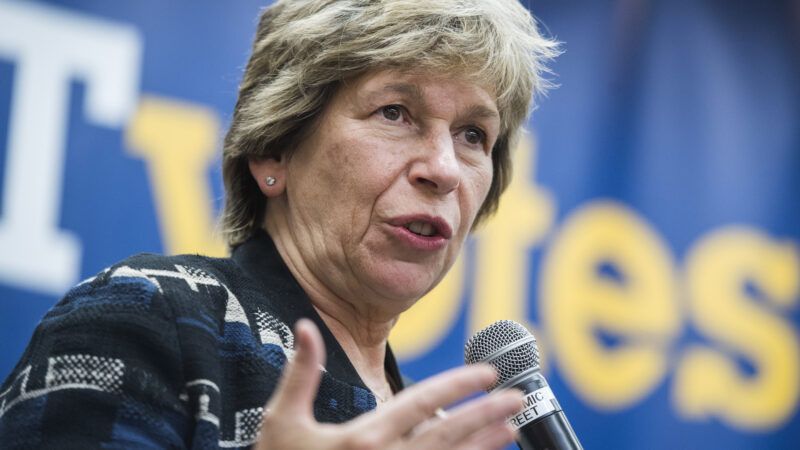Randi Weingarten's Hilariously Awful Media Rehabilitation Tour
Teachers union president tries to rebrand as a school-reopener, but parents aren't having it.

A funny thing happened this week during Randi Weingarten's P.R. campaign to falsely rebrand herself as a champion of school reopening: The American Federation of Teachers (AFT) president was forced to contend with actual parents who knew better.
In a C-SPAN appearance May 18, Weingarten got earfuls from callers upset about the negative influence that teachers unions have had on school quality, student preparedness, and COVID-19 response. "The part that I don't understand," said caller Larry, who described himself as an educator from North Carolina, "is, how come the parochial schools and the private schools could navigate their way through this scenario, but the public schools didn't seem to be able to manage that?"
Weingarten's answer was such dissembling, obfuscatory nonsense that it deserves to be read out in full:
So this is part of the reason why we asked the last administration to collect data on all of these things. So there were many many many public schools that have been open in a hybrid manner or in a full-time manner since September. And there have been many private schools, and many parochial schools [open]. And there have been many private and parochial schools that were not open. But we don't have the data, we have the anecdotal data. Fifteen percent, for example—a piece of data that I just got a couple of weeks ago—fifteen percent of parochial and private schools have closed fully during this period of time.
Many of the private schools that I know when I started asking them the questions about how are they doing this because we have to learn from each other, they said that they got the PPP loans that was in one of the first COVID packages so that they could do the testing that I just talked about, and they could do the layers of mitigation. And they also had parents, in a couple of the private schools, they had parents who shelled out a lot more money to do that. And the parochial schools, we saw some extra space that got used in those kind of ways.
And frankly, some of us also, you know, said that every one of the schools, you know, who were serving poor people had to get additional funding, and I got criticized by my, you know, public education friends for doing that. This is a matter of we have to learn from each other. But at the end of the day, if you have a ventilation system that doesn't work, if you don't have soap and water in your schools, if you can't get soap and water, and you need to have, you know, you need to wash kids, everyone needs to wash their hands, perhaps sanitizing stations, all of those things were resource-based things that were really important.
The beginning of Weingarten's answer would make it seem like an open question whether private schools were measurably more open than public schools, because "we don't have the data." This is intentionally misleading garbage. As I wrote in February, citing one of many many many studies showing similar data (as opposed to anecdotes):
Education Next, a publication by Harvard's Program on Education Policy and Governance, surveyed 2,155 parents of 3,762 students in K-12 (both public and private) in November and December…
The private/public splits in Education Next's data are striking: 60 percent of private school students attend full-time (out of the 67 percent who say they were given that option), compared to 24 percent attending government-run public school full-time (out 37 percent being offered)[.]
Weingarten paints a dystopian picture in which schools lack soap and water, which suggests an urgent follow-up question: So what have they been spending those billions of federal dollars on? There was the $13 billion in the Coronavirus Aid, Relief, and Economic Security (CARES) Act in March 2020, and the $54 billion in the COVID-19 relief bill in December 2020 (both on top of the Department of Education's annual $40 billion transfer to K-12 schools). Then there was the $81 billion already spent from the March 2021 American Rescue Plan (with another $41 billion being contingent on school reopening), plus $12 billion in school testing, and an estimated $70 billion extra that will trickle out over the coming years.
And we're talking soap and water?
Speaking of cleaning, Weingarten, who has been trying furiously since February to convince gullible/sympathetic reporters that she's been a school-reopening champ all along, advocated as recently as, well, February, that Washington, D.C., schools close automatically for a 24-hour scrub-down after a single positive COVID test, even though the science has been clear since at least the summer of 2020 that the virus is not being spread on surfaces.
To this day, even after delivering a big speech May 13 saying, "There is no doubt: Schools must be open. In person. Five days a week," Weingarten has continued to attach caveats and conditions that make the fall a doubtful enterprise for those public school families who live in areas where teachers unions hold heavy influence. She still wants reduced class sizes, maximal masking, distance-educating carveouts for teachers still scared to teach in class, and extra district/state monies in addition to the federal bonanza. She still warns darkly about variants, and says stuff like the Centers for Disease Control and Prevention's recent masking relaxation for vaccinated people "portends a potential surge of the virus."
So while Weingarten and her teachers union allies may still get some sympathetic ears in the press, there is something enjoyable about watching her have to confront the regular people in whose name she extracts ever more money from the government. At least until the bailout money can no longer cover the enrollment collapse.


Show Comments (62)